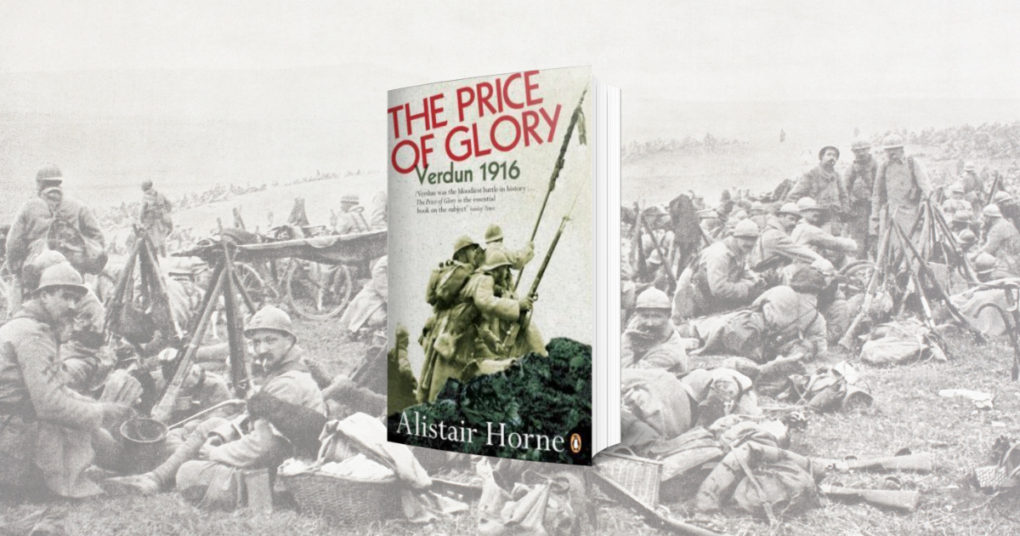The Price of Glory: Verdun 1916
Alistair Horne
Penguin Books
1994
388 pages
The Price of Glory: Verdun 1916 ranks among the best known history books of the twentieth century.
For ten months between February and December of 1916, the German and French forces fighting in the Battle of Verdun suffered 700,000 casualties between them. While working as a foreign correspondent in the 1950s, the much-acclaimed historian Alistair Horne was disturbed by the devastated landscape and haunted battlefield, and set out to document what had happened. Verdun indeed represented something distinct: a new and monstrous form of warfare where killing became an end in itself.
Before the battle began, the fortified city of Verdun lay within a salient before the German forces. By advancing towards it, the Germans knew they could draw in French reinforcements and then bombard them with artillery from three sides. To the German General Falkenhayn who conceived the plan, actually capturing Verdun was immaterial – he wanted to bleed France white.
“Never through the ages had any great commander or strategist proposed to vanquish an enemy by gradually bleeding him to death,” Horne wrote. “The macabreness, the unpleasantness of its very imagery could only have emerged from, and was symptomatic of, that Great War, where, in their callousness, leaders could regard human lives as mere corpuscles.”
In a strategic sense, the loss of Verdun would not have crippled France, and yet a tactical withdrawal was unthinkable. As an expert on French history, Horne was able to shed light on why the French became committed to a defence which came close to breaking the spirits of France’s soldiers, most of whom were rotated through Verdun at one point or another. Haunted by the memory of France’s collapse in the Franco-Prussian War of 1870-’71, their military leadership had committed itself to an aggressive approach which required defence against every German attack, and immediate counter-attack wherever ground had been lost.
Having gone to war to defend France’s soil and recover Alsace-Lorraine, they could never retreat from Verdun, a fact the Germans understood perfectly. The battle twisted the minds of the Germans as well. By late April, the stiff Gallic resistance had made clear that Verdun was not likely to fall, a view even the Kaiser’s son – one of the senior German commanders – shared. Yet the strategy to bleed France continued, as did the assault.
By July, when the last German offensive fell short, the Germans were faced with a similar choice of withdrawing from indefensible and worthless terrain or making the attacking French pay for every inch of ground they recovered. They too chose the latter option. Horne’s understanding of the historical context – everything from the power struggles within Germany’s ruling elite to the religious conflicts between the Catholics and the Republicans in the French officer corps – is what sets this account apart.
Like a true historian, he is constantly shining a light on how previous events influenced the conduct of the key actors, as well as how Verdun would set the stage for future developments: not least the tragic decision to base France’s future defence on the construction of the Maginot Line. Many more modern history books rely on visual aids – photographs, maps, etc – but they are little availed of here.
Horne relied on the gift of his storytelling and the quality of his prose to conjure up unforgettable images of this heartrending battle: the little French villages fought over until they were obliterated entirely; the concrete fortifications and the monstrous artillery pieces which shattered them and those inside; the flamethrowers and the poison gas; and above all else, the relentless shelling.
Of all the images, one stands out most vividly. When he toured the pock-marked and desolate battlefield in the 1950s, Horne noticed a small plaque erected by an anonymous French mother:
“To my son, since your eyes were closed mine have never ceased to cry.”
About the Author: James Bradshaw
James Bradshaw works for an international consulting firm based in Dublin, and has a background in journalism and public policy. Outside of work, he writes for a number of publications, on topics including politics, history, culture, film and literature.

